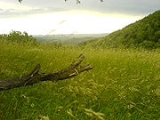
Rudnik
Encyclopedia
Rudnik is a mountain in central Serbia
, near the town of Gornji Milanovac
. Its highest peak Cvijićev vrh, named after geologist and biologist Jovan Cvijić
, has an altitude of 1132 meters above sea level. It has several other peaks over 1000 m: Srednji Šturac, Mali Šturac, Molitve, Paljevine and Marijanac.
The name translates literally to mine
, as the mountain is rich in mining resources.
Ostrvica or Ostrovica hill (758 m, 44°10′08"N 20°27′37"E) is located on the northwest of the Rudnik massif, sharply rising above the surrounding terrain. It is of volcanic origin and made of magmatic rocks, chiefly andesite
, suitable for masonry and road building. On the top of the hill lie the remains of a fortified city, whose exact origins are unknown. It was first mentioned in the fifth century CE, but is presumed to originate from the antic period. It was refortified by Serbian Despot
Đurađ Branković around 1430, who used it as a summer retreat with his family. The popular legend attributed the city building to his wife Eirene Kantakouzene
, already infamous for her role in building of the Smederevo Fortress
, and it is also referred to as Jerinin grad (Eirene's city).
Serbia
Serbia , officially the Republic of Serbia , is a landlocked country located at the crossroads of Central and Southeast Europe, covering the southern part of the Carpathian basin and the central part of the Balkans...
, near the town of Gornji Milanovac
Gornji Milanovac
Gornji Milanovac is a town and municipality located in Serbia at 44.012691° North, 20.273572° East. Its name means "Upper Milanovac" while Milanovac stems from name "Milan" in the Serbian language. The population of town is 24,048.The city was founded in 1853...
. Its highest peak Cvijićev vrh, named after geologist and biologist Jovan Cvijić
Jovan Cvijic
Jovan Cvijić was a Serbian geographer, president of the Serbian Royal Academy of Sciences, and rector of the University of Belgrade. A world-renowned scientist, Cvijić is considered the founder of geography in Serbia.-Early life and family:Jovan Cvijić was born on October 11 Jovan Cvijić...
, has an altitude of 1132 meters above sea level. It has several other peaks over 1000 m: Srednji Šturac, Mali Šturac, Molitve, Paljevine and Marijanac.
The name translates literally to mine
Mining
Mining is the extraction of valuable minerals or other geological materials from the earth, from an ore body, vein or seam. The term also includes the removal of soil. Materials recovered by mining include base metals, precious metals, iron, uranium, coal, diamonds, limestone, oil shale, rock...
, as the mountain is rich in mining resources.
Ostrvica or Ostrovica hill (758 m, 44°10′08"N 20°27′37"E) is located on the northwest of the Rudnik massif, sharply rising above the surrounding terrain. It is of volcanic origin and made of magmatic rocks, chiefly andesite
Andesite
Andesite is an extrusive igneous, volcanic rock, of intermediate composition, with aphanitic to porphyritic texture. In a general sense, it is the intermediate type between basalt and dacite. The mineral assemblage is typically dominated by plagioclase plus pyroxene and/or hornblende. Magnetite,...
, suitable for masonry and road building. On the top of the hill lie the remains of a fortified city, whose exact origins are unknown. It was first mentioned in the fifth century CE, but is presumed to originate from the antic period. It was refortified by Serbian Despot
Serbian Despotate
The Serbian Despotate was a Serbian state, the last to be conquered by the Ottoman Empire. Although the Battle of Kosovo in 1389 is generally considered the end of the medieval Serbian state, the Despotate, a successor of the Serbian Empire and Moravian Serbia survived for 70 more years,...
Đurađ Branković around 1430, who used it as a summer retreat with his family. The popular legend attributed the city building to his wife Eirene Kantakouzene
Eirene Kantakouzene
Irene Kantakouzene was the wife of Serbian Despot Đurađ Branković. In Serbian folk legends, she is the founder of many fortresses in Serbia.-Family:...
, already infamous for her role in building of the Smederevo Fortress
Smederevo Fortress
Smederevo Fortress , in Smederevo, Serbia, was a medieval fortified city and temporary capital of Serbia. It was built by Despot Đurađ Branković of 1427 to 1430, during the era of the Serbian Despotate. Later that century it was further fortified by the Turks...
, and it is also referred to as Jerinin grad (Eirene's city).
External links
- Veliki Šturac - Cvijić peak [Elevation (feet): 3714, Elevation (meters): 1132]

